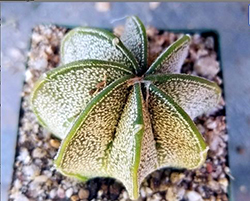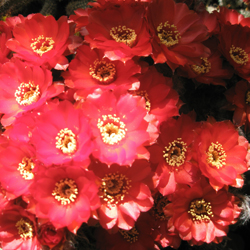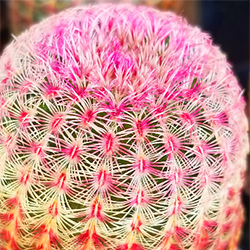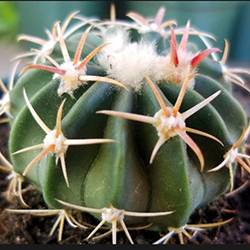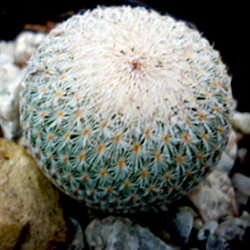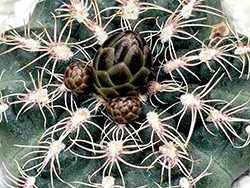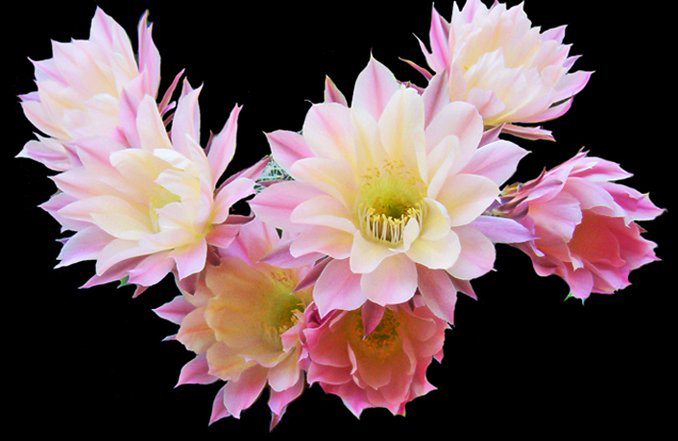

CACTUS
|
|
||
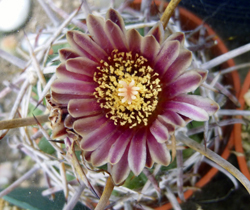 |
ANCISTROCACTUS
UNCINATUS
|
|
Rare Ancistrocactus Uncinatus, native to Mexico (Coahuila, Nuevo Leon, San Luis Potosi, Zacatecas).It is a solitary cylindrical cactus, up to 8 inches tall (20 cm), 3 inches in diameter (8 cm); 13 ribs; one central spine, hooked; 7 or 8 reddish radials.This cactus is a beautiful specimen for landscape or patio in temperate areas.'Ancistro' means 'hooked', relating to the central spines.This genus has now been absorbed in Sclerocactus.Requires porous cactus soil with adequate drainage.Bright light to full sun with ample airflow. Water thoroughly when soil is dry to the touch. Provide with ample airflow.Hardly water in the winter and protect from frostAll plants are shipped bare root, well packaged, healthy, free of pests & diseases.$21.00 | ||
|
|
ASTROPHYTUM
CAPRICORNE V NIVEUM |
|
This cactus hails from the region of Cuatro Cinegas in the centre of the state of Coahuila (Mexico).The variety ’niveum’ is the more northern of the capricornes. It grows in gravely soil among limestone rocks in a very dry area.It is a popular summer-growing species of relatively easy cultivation.All plants are shipped bare root, ,well packaged, healthy, free of pests & diseases.$20.00 |
||
|
|
ASTROPHYTUM
COAHUILENSE |
|
This cactus is narrowly distributed in the south-westernpart of the state of Coahuila and Durante (Ciudad Lerdo, Sierra Baicuco, western Sierra Parras and southern of this line up to the Sierra of El Numero), Mexico.They inhabit preferentially sunny south and east slopes on lime formations, rarely grow in north or west position between white grey rock in a loose to thick vegetation, which mainly consists of a dry bush community.All plants are shipped bare root, ,well packaged, healthy, free of pests & diseases.$19.00
|
||
 |
ASTROPHYTUM
ORNATUM |
|
The Astrophytum ornatum is the largest and easiest to grow and also the fastest of the Astrophytums. Spherical when young to columnar when mature, some specimen develop nice twists with age. Ribs have characteristic cross bands of wooly scales.Astrophytum ornatum is the southern genus of Astrophytum. The habitats are at Hidalgo, Queretaro, San Luis Potosí and Guanajuato in Mexico (extent of occurrence less than 8500 km2). In San Luis Potosí there is a hybrid zone with other Astrophytum species.It grows mostly in wild canyons and limestone cliffs sometime on near vertical rockfaces, it can also grow on rocks in deciduous forests. Its distribution in canyons is due to the specific parameters of humidity and temperature that are necessary for its growth and reproduction. Habitat destruction due to trampling from livestock (goats), land-use changes, mining, and illegal collection are the predominant threats.Flecking is different from plant to plant.All plants are shipped bare root, ,well packaged, healthy, free of pests & diseases.$15.00
|
||
|
|
CHAMAELOBIVIA
ROSE QUARTZ |
|
Chamaelobivia 'Rose Quartz' is a hybrid (between Chamaecereus and Lobvia) .This cactus has an upright growth habit, offsetting and blooming profusely. Flowers are to 3" in diameter, rose-colored, and tinged with purple highlights.Not only is 'Rose Quartz' very appealing, but also very resistant to insects such as mealy bugs, and to pathogens such as "soft rot".Requires porous cactus soil with adequate drainage. Prefers bright light and more temperate climates with good airflow. Becomes dormant in stifling summer heat as the original Chamaecereus is native to mountainous regions of South America.Water thoroughly when soil is dry during active growing season. Protect from frost.This plant is grown with organic,
pesticide-free methods.
|
||
|
|
ECHINOCEREUS
RIGIDISSIMUS v RUBRISPINUS |
|
Echinocereus rigidissimus rubrispinus
aka rainbow hedgehog cactus is one of the most visually appealing
cacti. Beautiful deep rose flowers to 4" in diameter with white
centers appear in late spring.
|
||
|
|
ECHINOCACTUS
TEXENSIS |
|
AKA Texas Horse Crippler and Homalocephala Texensis. This cactus hails from Texas, southeastern New Mexico, and Oklahoma (USA).It occurs also in northeastern Mexico (Chihuahua, Coahuila, southern Nuevo León, Durango, Tamaulipas and Zacatecas).
|
||
|
|
ECHINOCEREUS
TRIGLOCHIDIATUS LAGUNA |
|
E. triglochidiatus aka 'Claret Cup' is the most widespread species (Nevada, Utah, and Colorado south to southern California, Arizona, New Mexico, Texas, and Mexico).The flowers are a beautiful deep red, with many petals that form the shape of a cup. They bloom from April through June, and are the first to bloom in the desert.In general it is a mounding cactus, forming bulbous piles of from a few to hundreds of spherical to cylindrical stems.Plants may vary from densely spiny (usually) to no spines at all.All plants are shipped bare root, ,well packaged, healthy, free of pests & diseases$19.00 |
||
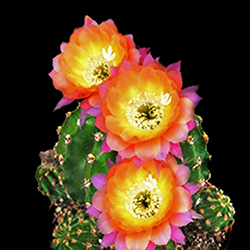 |
ECHINOPSIS
HYBRIDS |
|
Rainbow Bursts are so named for their spectacular display of flowers during the spring and summer.Flowers can be to 5" in diameter, and appear in all shades of white, gold, yellow, orange, pink, red, vivid purple and sometimes even bicolors!These hybrids are crosses (combined genetics) of Echinopsis species and Lobivia species, thus the name Echinobivia. The best characteristics of both genera are combined to create a robust, vigourously blooming and easy to care for plant.
|
||
|
|
||
|
|
EPITHELANTHA
MICROMERIS |
|
This small button cactus hails from Arizona (Santa Cruz and Cochise County) New Mexico (Hildalgo and Sandoval Co, From Sierra and Chaves to Eddy Co), western Texas, to Mexico (northern Chihuahua).All plants are shipped bare root, ,well packaged, healthy, free of pests & diseases$17.00
|
||
 |
ESCOBARIA TUBERCULOSA | |
Pelecyphora tuberculosa (syn. Escobaria tuberculosa), also known as White Column Foxtail Cactus, Cob Cactus, Corn Cob, Cob-Cory Cactus, Corn Cob Cactus, Arizona Pincushion, Corncob Cactus, Incense Cory Cactus, is a species of flowering plant in the family Cactaceae, native to the south-central United States, and northern Mexico.The species grows in rocky slopes, limestone or igneous, in desert scrub, in crevices and cliffs.It is easy to cultivate in a very gritty substrate with much drainage.Water regularly in summer, but do not overwater (very rot prone), it prefer a completely dry place during winter. An unheated greenhouse would be perfect. It can survive low temperatures (appr. -12 C). Full sun to light shade.A gorgeous cactus in any collection!
|
||
|
|
||
 |
FEROCACTUS
FORDII |
|
Seed grown handsome plant with a relatively restricted range in the Pacific coast of Baja California and Baja California Sur, Mexico, Northern America.The species occurs in the Sonoran desert scrub in flat sandy areas, and in coastal sand dunes and flat grassy areas. It is heavily collected illegally and is affected by several threats, such as urban development, industrial activities, and fish camps which cause a continuing decline in habitat quality and the extent of the species range.All plants are shipped bare root, ,well packaged, healthy, free of pests & diseases$17.00
|
||
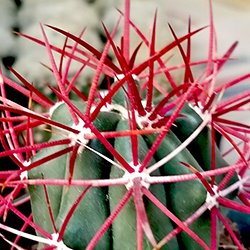 |
FEROCACTUS
GRACILIS SSP COLORATUS |
|
Ferocactus Gracilis Coloratus comes only from the area between Punta Pricta and Miller's Landing, Baja California, North West Mexico.It is a particularly attractive cactus with remarkably red spines.In habitat It is a large solitary, ribbed barrel cactus, becoming cylindric in age and attaining an exceptional height of 3 metres.The flowers are gorgeous - reddish with darker red midveins.A must for any passionate collector.All plants are shipped bare root,
,well packaged, healthy, free of pests & diseases
|
||
|
|
FEROCACTUS
TOWNSENDIANUS |
|
This rare cactus hails from Baja California, North West Mexico South of California.Slow growing to start but does well under cultivation.Use very draining soil, water during the growth cycle but avoid wetting the bodies of these plants while they are in sunlight.All plants are shipped bare root, ,well packaged, healthy, free of pests & diseases$30.00 CURRENTLY SOLD OUT BUT SEND INQUIRY FOR
NEXT AVAILABILITY - absolutely_cactus@yahoo.com
..
|
||
 |
GYMNOCALYCIUM
BALDIANUM |
|
Gymnocalycium Baldianum, spider-cactus or dwarf chin cactus, is a species of flowering plant native to the Catamarca Province in Argentina.Extremely free flowering it makes a splendid show.This is a plant to be suggested to all cactus lovers for its very eye-catching flowers even at a very small size.It flowers readily from an early age, and offers no cultivation difficulties.All plants are shipped bare root, ,well packaged, healthy, free of pests & diseases$19.00
|
||
|
|
GYMNOCALYCIUM
BRUCHII ssp BRUCHII |
|
Gymnocalycium Bruchii is one of the most cold-tolerant South American species.It can grow outdoors, and is hardy to -15° C or less.It is a summer grower species that is easy to cultivate. It is an excellent plant for container growing.It always looks good and stays small. It look fine in a cold greenhouse and frame or outdoor in a rockery.All plants are shipped bare root, ,well packaged, healthy, free of pests & diseases$17.00
|
||
|
|
GYMNOCALYCIUM
DAMSII v. TUCAVOCENSE |
|
Gymnocalycium Damsii v. Tucavocense is a gorgeous Gymnocalycium; the body color changes from pink to purple to green depending on light conditions.It hails from the Tucavaca Valley and adjacent areas, Santa Cruz and San Jose, Bolivia.All plants are shipped bare root, ,well packaged, healthy, free of pests & diseases$19.00
|
||
|
|
GYMNOCALYCIUM
MESOPOTAMICUM |
|
Gymnocalycium Mesopotamicum grows in Corrientes, Mercedes, Argentina.Gymnocalycium Mesopotamicum has been reported to grow in a very small area.It is a small cactus often solitary in habitat, but freely branching in cultivation where it makes pleasing clumps. It flowers profusely with white flowers with reddish throats.This plant needs plenty of space for its roots, repotting should be done every other year or when the it has outgrown its pot.All plants are shipped bare root, ,well packaged, healthy, free of pests & diseases$19.00
|
||
|
|
GYMNOCALYCIUM
SCHATZLIANUM |
|
Gymnocalycium Shatzlianum is a clumping cactus, known to flowering easily, and is a very good beginner cacti.This gorgeous Gymno is one of the very few that have striking yellow flowers.All plants are shipped bare root, ,well packaged, healthy, free of pests & diseases$20.00
|
||
|
|
||
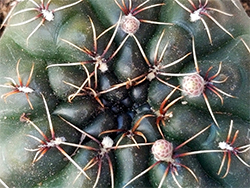 |
GYMNOCALYCIUM SCHROEDERIANUM ssp. BOESSII |
|
|
G. schroederianum ssp. boessii originates in Argentina in Buenos Aires, Corrientes, Santa Fe and Entre Ríos, and in Uruguay in Río Negro.It has a low dark green body with short spines held close, and white flowers.This cactus grows in open forest on clay soil that frequently becomes flooded. It occurs near the tops of the range of hills by the town of Olavarría, the Sierra Bayas and other nearby Sierras in the south of Buenos Aires province.Gymnocalycium schroederianum is an attractive low growing cactus species barely rising above ground level, usually solitary in habitat, but on occasion form clusters in cultivation.All plants are shipped bare root, ,well packaged, healthy, free of pests & diseases$19.00
| ||
|
|
||
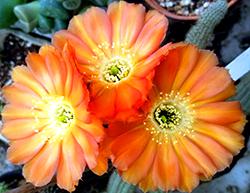 |
LOBIVIA HEAMATANTHA V AMBLAYENSIS
|
|
|
Primarily grown for its large, showy and amazing flowers, this is a summer grower species that offers no cultivation difficulties. Water regularly in summer (but do not over-water ) needs good drainage and very porous soil. Keep rather dry in winter. This one hails from Amblayo, Salta, Argentina. All plants are shipped bare root, ,well packaged, healthy, free of pests & diseases$27.00 CURRENTLY SOLD OUT BUT SEND INQUIRY FOR
NEXT AVAILABILITY - absolutely_cactus@yahoo.com
..
| ||
|
|
||
 |
MALACOCARPUS ERINACEUS
|
|
|
Malacocarpus Erinaceus is a simple, flattened-globular to short-cylindrical cactus and becomes very woolly at the top It originates in Argentina (Buenos Aires, Córdoba, Entre Ríos, La Pampa, Rio Negro, San Luis, Santiago del Estero); Brazil (Rio Grande do Sul); Uruguay.The major threats are grazing and forestry. Illegal collection can potentially become a threat.All plants are shipped bare root, ,well packaged, healthy, free of pests & diseases$19.00 | ||
|
|
||
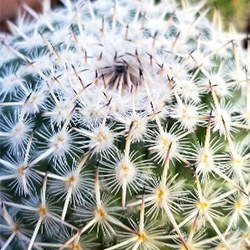 |
MAMMILLARIA ALBILANATA ssp. FAUXIANA
|
|
|
This species is endemic to SW Mexico, where it occurs in the states of Chiapas, Colima, Guerrero, Oaxaca and Puebla. It is relatively rare and uncommon. Habitat destruction for cattle ranching and small-scale farming is having an impact on these.The major threats are grazing and forestry. Illegal collection can potentially become a threat.This is a clumping cactus with beautiful maroon flowers.All plants are shipped bare root, ,well packaged, healthy, free of pests & diseases$17.00
| ||
|
|
||
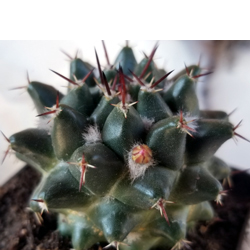 |
MAMMILLARIA MAGNIMAMMA PRIESSNITZII
|
|
|
This Mammillaria grows in dry rocky places in the open. Mammillaria magnimamma is one of the few cacti species that has colonized barren lava fields in Mexico. It is easy to grow, and looks very attractive and unusual. Over time it will produce large clumps. All plants are shipped bare root, ,well packaged, healthy, free of pests & diseases$17.00 | ||
|
|
||
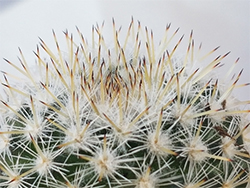 |
MAMMILLARIA MORGIANA
|
|
|
Mammillaria morganiana, commonly called owl's eyes or owl-eye pincushion. The name morganiana honors the U.S. optometrist Meredith Walter Morgan (1887-1957) of Richmond. This species is native to the Mexican state of Guanajuato. It is easy to grow, and looks very attractive and unusual. Over time it will branch or clump and the centers will look like owls eyes. All plants are shipped bare root, ,well packaged, healthy, free of pests & diseases$18.00 | ||
|
|
||
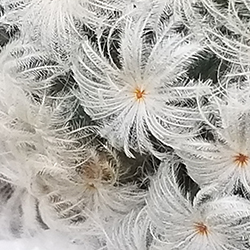 |
MAMMILLARIA PLUMOSA
|
|
|
Mammillaria plumosa, the feather cactus, with aromatic, sweet smelling blooms is native to Northeastern Mexico. The clustering spherical stems are completely covered in white downy spines These cacti tend to grow low to the ground, often forming groups or clusters. A gorgeous cactus in any collection! All plants are shipped bare root, ,well packaged, healthy, free of pests & diseases
$18.00
| ||
|
|
||
 |
MAMMILLARIA SENILIS
|
|
|
Mammillaria senilis, It is native to Mexico, where it is found in the states of Chihuahua, Durango, Jalisco, Nayarit, Sinaloa and in south Zacatecas. It grows on moss-covered boulders in pine forests at high altitudes. It needs a lot of light and good airflow. Water regularly in summer, but do not overwater. Water thoroughly only if soil is dry to the touch, let soil dry in between to prevent root rot, keep very dry in winter. Use a very porous potting media with excellent drainage, as can be achieved by using more perlite or pumice in the mix. The flowers are large and quite showy! All plants are shipped bare root, ,well packaged, healthy, free of pests & diseases$19.00 | ||
|
|
||
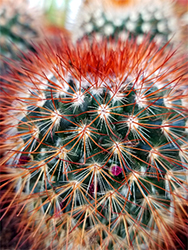 |
MAMMILLARIA SPINOSISSIMA (RED HEADED IRISHMAN)
|
|
|
Mammillaria Spinosissima - Red Headed Irishman is one of the most beautiful mammillarias. Round at first, Mammillaria spinosissima grows to 8" in height, forming clumps of columns densely spined with reddish-orange spines. It is sclosely related to Mammillaria pilcayensis. This Mexican native will form clumps of columns with red spines. The gleaming flowers form circles atop the stems in late winter and spring; It has stunning rings of brilliant magenta flowers.. This cactus is easy to grow and can grow well even if neglected. These cacti tend to grow low to the ground, often forming groups or clusters. A gorgeous cactus in any collection! All plants are shipped bare root, ,well packaged, healthy, free of pests & diseases$17.00
| ||
|
|
||
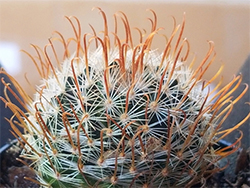 |
MAMMILLARIA STELLA-DE-TACUBAYA
|
|
|
This beautiful Mammillaria is native to Mexico, where it is found in Rio Nazas, Rancho de Tacubaya and adjacent areas, and in Durango. It grows on gentle slope or flat calcareous area on hillsides M. Stella-de-Tacubaya is tiny Mammillaria species of the series Lasiacanthae. This rarely found species needs bright light, very careful application of water, ample airflow and is not one of the easiest to grow, but if you succeed in growing it then the results will repay all the growing efforts. It rewards the patient grower with a beautiful displays of flowers since from an early age. All plants are shipped bare root, ,well packaged, healthy, free of pests & diseases$19.00 | ||
|
|
||
 |
MAMMILLARIA TENZONTLE (Extinct in Habitat)
|
|
|
Mammillaria tenzontle was found North of the city of San Luis Potosi. It was found on volcanic rocks where the population became extinct after destruction of the habitat. It is a minuscule cactus with delicate near harmless feathery spines densely wrapped against the body of the plant. Definately a must in any collection to keep these plants going. Well worth preserving! Seed grown. All plants are shipped bare root, ,well packaged, healthy, free of pests & diseases $21.00
| ||
|
|
||
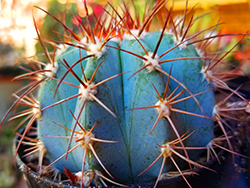 |
MELOCACTUS AZUREUS
|
|
|
Melocactus azureus is native to central, northern, and eastern Brazil at altitudes of 450-800 meters above sea level. This species has a small range and is only in low-lying outcrops of limestone. It occurs in fragmented populations. A major threat to the species is habitat loss die to agriculture; the vegetation is destroyed when the surrounding Caatinga forest is cleared causing a decline of the wild populations. Also called Turk's cap cactus, it develops a tall Cephalium or cap. The magenta flowers grow out of it in spring to late fall. The root system is weak and generally resents being re-potted and can take a long time to re-establish. Use pot with good drainage. Melocacti grow from April to October and cannot endure long stretches of total dryness, and also too much water will rot them, as their weak root systems tends to be inefficient at sucking up water from wet soil. Nonetheless, again as a result of their tropical origins, they need a fair amount of water, but allow the soil to dry quite a bit before watering again. Fertilize in summer only if the plant hasn't been re-potted recently. Do not feed the plants from September onward as this can cause lush growth which can be fatal during the darker cold months. Melocactus rest from October to April but can’t stand cold, or even fairly cool temperatures, so is indispensable to keep them above 8-12°C at all times. A must for any passionate collector. All plants are shipped bare root, ,well packaged, healthy, free of pests & diseases $19.00
| ||
|
|
||
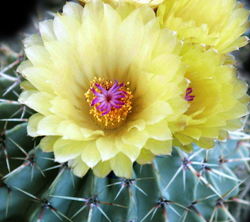 |
NOTOCACTUS BUININGII
|
|
|
Notocactus Buiningii originates from Southern Brazil, northern Uruguay. It is a solitary, flattened cactus only a few cm in height with long, straw-yellow spines. It bears large and showy yellow flowers, and produces hairy fruit and black seeds. This is an easy plant to cultivate. It likes to be kept cool, and needs only a short rest in winter. It can can tolerate light frost. All plants are shipped bare root, ,well packaged, healthy, free of pests & diseases $21.00
| ||
|
|
||
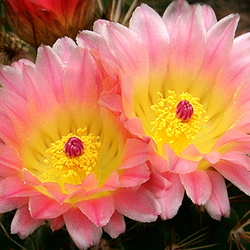 |
NOTOCACTUS HERTERI SSP ROSEOLUTEUS
|
|
|
This variety is distributed throughout southern Brazil (Rio Grande do Sul), all of Uruguay and northern Argentina It is usually solitary or slowly branching from the base with Yellow/brown spines, and pink/light salmon flowers with yellow throat up to 8 cm in diameter. It is suitable for the home or a greenhouse, During winter's rest period they should be dry and cool, it is frost resistant to -4°C but thrives best with additional heat, they like only a short winter's rest. Prefers filtered bright light with ample airflow. All plants are shipped bare root, ,well packaged, healthy, free of pests & diseases $23.00
| ||
|
|
||
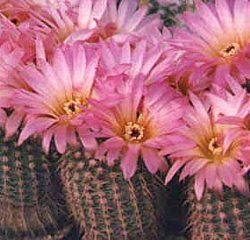 |
NOTOCACTUS RUTILANS
|
|
|
Notocactus Rutilans is a small-growing, usually solitary, cactus species. The numerous stiff, sharp spines are varicoloured and the centrals are reddish-brown. The flowers are very showy, 5 cm long, with much white wool along the tubes, and translucent petals, salmon to carmine-red shading to egg-yolk yellow in the centre. The plants are very free-flowering and self- fertile; producing many seeds. When in flower the whole plant shimmers with color and it flowers when quite young. It likes a warm bright location, does great in partial shade but doesn't like full, hot blazing sun in the summer month. All plants are shipped bare root, ,well packaged, healthy, free of pests & diseases $19.00
| ||
|
|
||
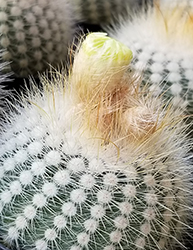 |
NOTOCACTUS SCOPA (Silver Ball)
|
|
|
Native to Southern Brazil (Rio Grande do Sul), Uruguay, Paraguay, northern Argentina, it is a ball- or cylinder-shaped cactus growing to 5–50 cm tall by 10 cm broad, with a spiny, woolly crown and pale yellow flowers in summer. It grows in grasslands. It is easy to grow. It prefers a neutral to slightly acidic mineral-based potting mix with a good drainage. It likes a warm bright location, does great in partial shade but doesn't like full, hot blazing sun in the central summer month. Can support quite some water during the growing season but pot plants in winter are wet-sensitive and needs to be kept dry All plants are shipped bare root, ,well packaged, healthy, free of pests & diseases $17.00
| ||
|
|
||
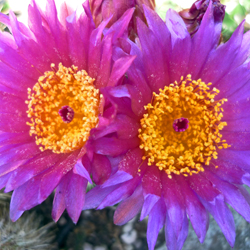 |
NOTOCACTUS UEBELMANNIANUS
|
|
|
It is native to Brazil in the area of Rio Grande Do Sul. It grows in flattened rocky terrains amongst agricultural land. It is seriously endangered in its native habitat as much of the land is cultivated for arable crops or grazing pasture. It is easy to grow. It is a relatively rapidly growing species that will make large clumps given the best conditions. All plants are shipped bare root, ,well packaged, healthy, free of pests & diseases $18.00
| ||
|
|
||
 |
STENOCEREUS PRUINOSUS
|
|
|
Stenocereus pruinosus is cultivated due to its edible fruit and beautiful banding. It is a striking and well distributed in Mexico in the states of Oaxaca, Puebla and Veracruz (and also Guerrero and Chiapas ). The species is cultivated due to its edible fruit. This cactus is also known as 'pitayo de Octubre' or 'pitayo de mayo' in Mexico, which indicates its ripens mainly around October and May. Flowers open in from late February to May and later in September as around the clock bloomers to exploit both day and night flying pollinators and produces fruits between May and October. It is a valuable food source in Mexico where its fruit is harvested and sold in some rural markets. This is an easy to grow cactus but not cold hardy. It is a popular potted plant indoors and out provided the potting soil is sufficiently porous and well drained. With age, the banding and markings become more pronounced making it a striking addition to your collection. All plants are shipped bare root, ,well packaged, healthy, free of pests & diseases $19.00
| ||
|
|
||
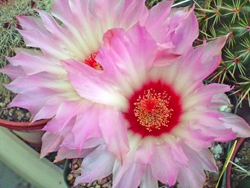 |
THELOCACTUS BICOLOR ssp. FLAVIDISPINUS
|
|
|
This cactus comes from the Chihuahuan Desert vegetation in Texas and, possibly, neighboring Mexico. it is a globular usually solitary cactus. The plants are very free-flowering and self- fertile; producing many seeds. When in flower the whole plant shimmers with color and it flowers when quite young. It is a relatively rapidly growing and easily flowering species that will make clumps given the best conditions. . All plants are shipped bare root, ,well packaged, healthy, free of pests & diseases $19.00
| ||
|
|
||
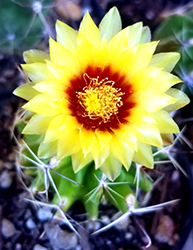 |
THELOCACTUS SETISPINUS v SETISPINUS
|
|
|
This cactus hails from Rio Grande City, Jim Hogg and Starr County, Southern Texas, USA It is a typically solitary cactus that sometime will offsets from it’s base. This species produces a lot of fragrant yellow, orange-eyed flowers at the top of the stem. An attractive blooming machine. It flowers very well, even when quite young, producing lots flowers in succession all Summer. This species is easy and well worth growing. Require little care once they have reached a nice flowering size. All plants are shipped bare root, ,well packaged, healthy, free of pests & diseases $19.00
| ||
|
|
||
 |
TURBINICARPUS DICKISONIAE |
|
|
This gorgeous Turbinicarpus hails from near Aramberri in the state of Nuevo Leon (Mexico). Altitude 1200m. It typically will grow solitary but may on occasion cluster, with long, white, wool in youth becoming bare later. This species is easy to cultivate but slow growing, needs care with watering to avoid abnormal growth and to keep plant compact. It is cold hardy to -4°C for a short period and do best in filtered light exposures. All plants are shipped bare root, ,well packaged, healthy, free of pests & diseases $27.00
| ||
|
|
||
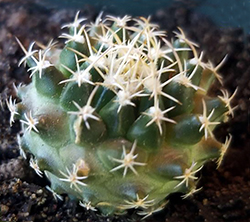 |
TURBINICARPUS SAUERI SSP NIEBLAE (San Carlos)
|
|
|
This one hails from North of Ciudad Victoria, Tamaulipas, Municipio San Carlos, Mexico (it is the only Turbinicarpus know that grows out of the Sierra Madre Oriental). It grows among stones and grasses in a very hot climate (mean annual temperatures 24-26°C) and with elevated rainfall ( 800 mm rain/annum). The soil is calcareous but with a good percentage of organic matter. The flowers are white with a pink to dark violet midvein. All plants are shipped bare root, ,well packaged, healthy, free of pests & diseases $23.00
| ||
|
|
||
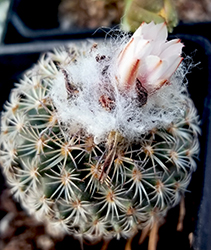 |
TURBINICARPUS SAUERI SSP YSABELAE
|
|
|
This Turbinicarpus is usually a solitary cactus almost completely concealed by spines and wool. It grows near Tula. The wild population is less than 250 individuals confined to a single location less than 1 km (100x200 m), where it continues to decline as a result of illegal collecting and San Luis de Potosi, Rancho el Vergel. All plants are seed grown to ensure the continued existence of these cacti. All plants are shipped bare root, ,well packaged, healthy, free of pests & diseases $25.00
| ||
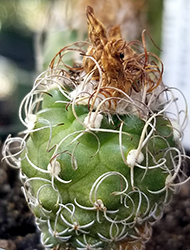 |
TURBINICARPUS PSEUDOMACROCHELE (Cardonal, Hidalgo)
|
|
|
This Turbinicarpus comes from (Cardonal)Hidalgo, Mexico. T. Pseudomacrochele is known from 11 subpopulation in less than five locations The population is declining due to the ongoing removal of plants by collectors both for human consumption (narcotic) and for ornamental purposes. The total population size is less than 2,500 mature individuals. Mining of limestone for cement production is also a threat in some places. All plants are seed grown. All plants are shipped bare root, ,well packaged, healthy, free of pests & diseases $25.00
|
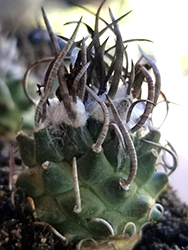 |
TURBINICARPUS SCHMIEDICKEANUS SSP SCHMIEDICKEANUS
|
|
|
Turbinicarpus Schmiedickeanus ssp Schmiedickeanus is usually found in Tamaulipas, Nuevo Leon and San Luis Potosi, Mexico. Altitude: 1500-1800 metres above sea level. Illegal collecting is the major threat, and overgrazing and subsequent erosion poses a lesser threat. All plants are seed grown to ensure the continued existence of these cacti. All plants are shipped bare root, ,well packaged, healthy, free of pests & diseases. CURRENTLY SOLD OUT BUT SEND INQUIRY FOR
NEXT AVAILABILITY - absolutely_cactus@yahoo.com
.. $30.00
|
